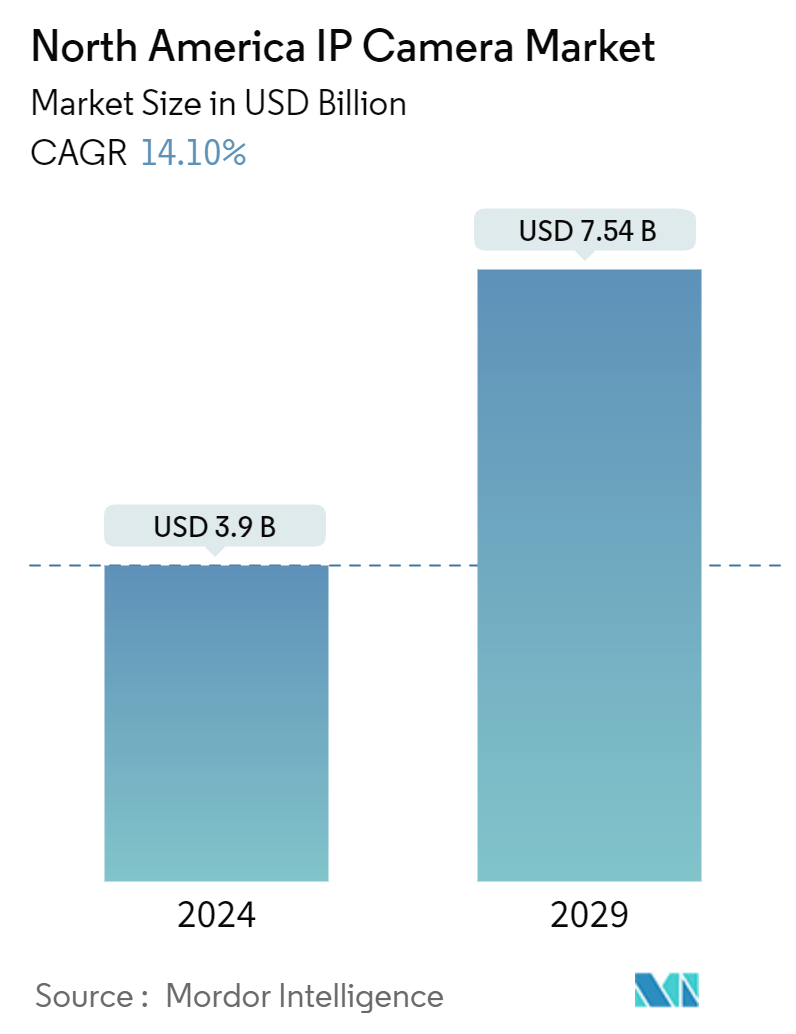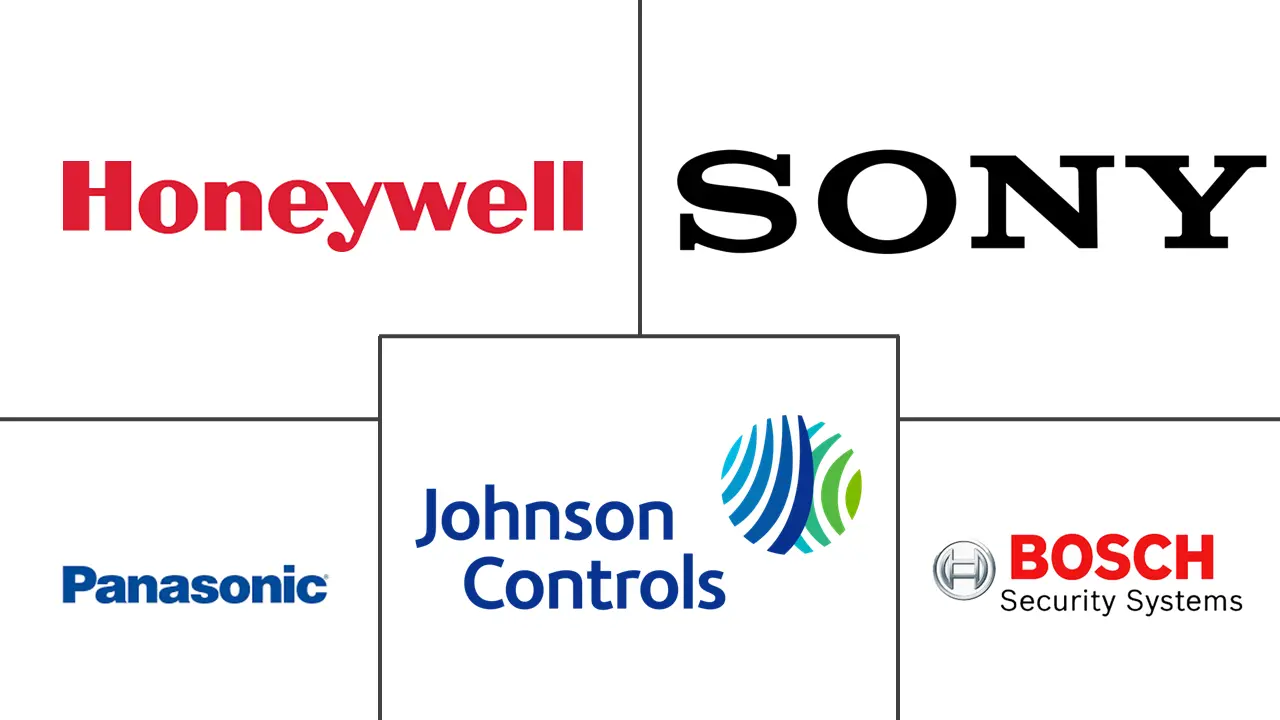Market Size of North America IP Camera Industry

| Study Period | 2018 - 2029 |
| Base Year For Estimation | 2023 |
| Market Size (2024) | USD 3.9 Billion |
| Market Size (2029) | USD 7.54 Billion |
| CAGR (2024 - 2029) | 14.10 % |
| Market Concentration | Low |
Major Players
*Disclaimer: Major Players sorted in no particular order |
North America IP Camera Market Analysis
The North America IP Camera Market size is estimated at USD 3.9 billion in 2024, and is expected to reach USD 7.54 billion by 2029, growing at a CAGR of 14.10% during the forecast period (2024-2029).
- IP cameras, or internet protocol cameras, are digital security cameras that receive and send video footage via an IP network. Unlike analog closed-circuit television cameras, IP cameras do not need a local recording device, only a local network. The IP cameras are equipped with a processing chip that compresses the video footage as it is recorded. The higher the camera resolution, the more data each video recording contains, which requires more storage space and bandwidth for transmission.
- IP cameras have evolved from conventional analog cameras to digital cameras that transmit video data over an IP network. These cameras offer superior image quality, higher resolution, and advanced features like facial recognition and video analytics. Technological advancements have improved IP cameras' performance and made them more affordable & accessible to a wider consumer base in North America.
- IP cameras often incorporate advanced video analytics capabilities, such as motion detection, object tracking, and facial recognition. These intelligent features enhance the effectiveness of surveillance systems by automatically alerting operators to suspicious activities or events. Video analytics also enable efficient post-event analysis, helping in investigations and evidence collection.
- The rise of IoT applications has further fueled the adoption of IP cameras. With the increasing interconnectivity between devices and the growing popularity of smart homes and smart cities, IP cameras play a critical role in enhancing security and providing real-time monitoring. IP cameras can be seamlessly integrated with other IoT devices, like motion sensors and alarms, creating a comprehensive surveillance ecosystem. This integration allows for automated responses to events, such as triggering alarms or sending notifications to authorized personnel, enhancing overall security and efficiency.
- The integration of AI in IP cameras is expected to augment the demand for the studied market. To that extent, in May 2023, CHeKT launched a new line of AI IP cameras that feature advanced AI tracking algorithms, a rich library of detection behaviors, which is claimed to offer deep learning features that facilitate the cameras to learn and identify the objects detected and offer true human & vehicle type identification, to remove any false objects that might trigger detections.
- However, the lack of interoperability between different camera brands and software platforms poses a significant restraint to the growth of the studied market. This limits the flexibility and scalability of IP camera systems, making it difficult for customers to integrate cameras from different manufacturers.
- Further, the initial cost of IP camera systems, including cameras, storage devices, and network infrastructure, can be prohibitive for small and medium-sized businesses. Additionally, the ongoing costs associated with maintaining and upgrading these systems can burden businesses with limited budgets. The high cost of IP camera systems often leads businesses to opt for traditional analog camera systems, which are more affordable but lack the advanced features and capabilities of IP cameras.
- • Income levels, demographic changes, and cultural preferences can also impact the demand for IP cameras. According to the International Monetary Fund (IMF), the gross domestic product (GDP) of the United States increased from USD 33.58 trillion in 2022 to USD 34.95 trillion in 2023. The robust economy of the United States is likely to aid the development of the studied market.
North America IP Camera Industry Segmentation
The North America IP Camera market is segmented by type (fixed, Pan-Tilt-Zoom (PTZ), and varifocal), end-user industry (residential, commercial [BFSI, education, healthcare, real estate, retail], industrial, government and law enforcement), and country (United States, Canada). The market sizes and forecasts are provided in terms of value (USD) for all the above segments.
For market estimation, we have tracked the revenue generated from the sale of IP cameras offered by different market players in North America for a diverse range of applications. The market trends are evaluated by analyzing significant market players' investments in product innovation, diversification, and expansion efforts. Further, the advancements in image quality, video analytics, connectivity, artificial intelligence & machine learning algorithms, and advancements in cybersecurity are also crucial in determining the growth of the studied market.
| By Type | |
| Fixed | |
| Pan-Tilt-Zoom (PTZ) | |
| Varifocal |
| By End-User Industry | |
| Residential | |
| Commercial (BFSI, Education, Healthcare, Real Estate, Retail) | |
| Industrial | |
| Government and law enforcement |
| By Country | |
| United States | |
| Canada |
North America IP Camera Market Size Summary
The North America IP camera market is experiencing significant growth, driven by technological advancements and the increasing demand for enhanced security solutions. IP cameras, which transmit video data over IP networks, offer superior image quality and advanced features such as facial recognition and video analytics. These cameras have become more affordable and accessible, thanks to technological improvements, making them a preferred choice over traditional analog systems. The rise of IoT applications and smart home integrations further propels the market, as IP cameras can seamlessly connect with other devices to create comprehensive security ecosystems. However, challenges such as interoperability issues between different brands and the high initial costs of IP camera systems remain barriers for some businesses, particularly small and medium-sized enterprises.
The market is characterized by the presence of several key players, including Johnson Controls International plc, Honeywell International Inc., and Sony Corporation, who are actively investing in research and development to innovate and meet evolving consumer demands. The introduction of cloud-based solutions and the decreasing cost of IP cameras are significant factors contributing to market expansion. These solutions offer scalable and cost-effective options for video storage and management, reducing the need for on-site infrastructure. Additionally, the integration of IP cameras with smart home systems in the residential sector is expected to drive further growth. The market's fragmentation and the ongoing advancements in AI and video analytics technologies indicate a competitive landscape, with companies continuously striving to enhance their product offerings.
North America IP Camera Market Size - Table of Contents
-
1. MARKET INSIGHTS
-
1.1 Market Overview
-
1.2 Industry Attractiveness - Porter's Five Force Analysis
-
1.2.1 Threat of New Entrants
-
1.2.2 Bargaining Power of Consumers
-
1.2.3 Bargaining Power of Suppliers
-
1.2.4 Threat of Substitute Products
-
1.2.5 Intensity of Competitive Rivalry
-
1.2.6 Threat of New Entrants
-
-
1.3 Industry Value Chain Analysis
-
1.4 Technological Advancements
-
1.5 Impact of COVID-19 and Macro Economic Trends on the Industry
-
-
2. MARKET SEGMENTATION
-
2.1 By Type
-
2.1.1 Fixed
-
2.1.2 Pan-Tilt-Zoom (PTZ)
-
2.1.3 Varifocal
-
-
2.2 By End-User Industry
-
2.2.1 Residential
-
2.2.2 Commercial (BFSI, Education, Healthcare, Real Estate, Retail)
-
2.2.3 Industrial
-
2.2.4 Government and law enforcement
-
-
2.3 By Country
-
2.3.1 United States
-
2.3.2 Canada
-
-
North America IP Camera Market Size FAQs
How big is the North America IP Camera Market?
The North America IP Camera Market size is expected to reach USD 3.9 billion in 2024 and grow at a CAGR of 14.10% to reach USD 7.54 billion by 2029.
What is the current North America IP Camera Market size?
In 2024, the North America IP Camera Market size is expected to reach USD 3.9 billion.

